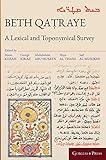Beth Qaṭraye : A Lexical and Toponymical Survey / Mario Kozah, George Kiraz.
Material type: TextSeries: Gorgias Eastern Christian Studies ; 58Publisher: Piscataway, NJ : Gorgias Press, [2021]Copyright date: ©2021Description: 1 online resource (460 p.)Content type:
TextSeries: Gorgias Eastern Christian Studies ; 58Publisher: Piscataway, NJ : Gorgias Press, [2021]Copyright date: ©2021Description: 1 online resource (460 p.)Content type: - 9781463241391
- 9781463241407
- 492.7/7
- DS247.Q35 K69 2021
- online - DeGruyter
| Item type | Current library | Call number | URL | Status | Notes | Barcode | |
|---|---|---|---|---|---|---|---|
 eBook
eBook
|
Biblioteca "Angelicum" Pont. Univ. S.Tommaso d'Aquino Nuvola online | online - DeGruyter (Browse shelf(Opens below)) | Online access | Not for loan (Accesso limitato) | Accesso per gli utenti autorizzati / Access for authorized users | (dgr)9781463241407 |
Frontmatter -- TABLE OF CONTENTS -- ACKNOWLEDGMENTS -- PREFACE -- THE EDITORS -- ABBREVIATIONS -- INTRODUCTION -- A LEXICAL SURVEY OF QAṬRĀYĪTH -- A TOPONYMICAL SURVEY OF BETH QAṬRAYE -- THE POLITICAL, ECONOMIC, AND SOCIAL SITUATION OF THE ISLANDS IN THE GULF REGION DURING THE THIRD AND FOURTH / NINTH AND TENTH CENTURIES -- A RECONSTRUCTION OF THE LEXICON OF ḤENANISHOʿ BAR SAROSHWAY -- BIBLIOGRAPHY OF WORKS CITED -- INDICES
restricted access online access with authorization star
http://purl.org/coar/access_right/c_16ec
Beth Qaṭraye, Syriac for “region of the Qataris,” is a term found in Syriac literature referring to the region of north-eastern Arabia, including modern-day Qatar and Bahrain, from the fourth to the ninth centuries. Beth Qaṭraye was an important cultural, linguistic and religious crossroads in the pre-Islamic and early Islamic period, when it produced a number of important East-Syriac authors. Scholarship has so far only focused on these Syriac authors and their writings rather than other aspects of Beth Qaṭraye. This volume presents and analyzes information on the pre-Islamic and early Islamic historical geography and toponyms of the Beth Qaṭraye region as well as newly discovered vocabulary from a language referred to as Qaṭrāyīth (“in Qatari”) used by its inhabitants. Based on analysis of this new data, Mario Kozah argues that Qaṭrāyīth is in fact a local Arabic dialect transliterated using Syriac letters. Thus, Qaṭrāyīth consists mostly of Arabic vocabulary (as well as a few Syriac and Pahlavi loanwords), and maintains mainly Arabic with some Syriac grammatical structures and lexical influence. As such, it constitutes the oldest documented Arabic vernacular from the seventh-century Arabian Peninsula, revealing a language in rapid transformation. The volume also includes a special chapter on the islands of the Gulf region according to Muslim sources by Saif Al-Murikhi and a unique reconstruction of the lexicon of Ḥenanishoʿ bar Seroshway (ca. 900) by George Kiraz.
Mode of access: Internet via World Wide Web.
In English.
Description based on online resource; title from PDF title page (publisher's Web site, viewed 25. Jun 2024)


